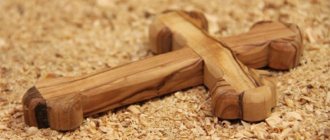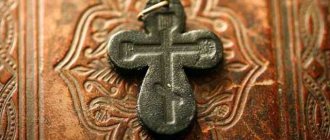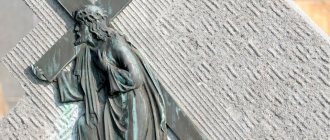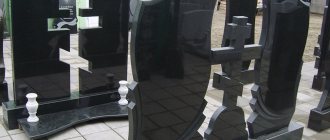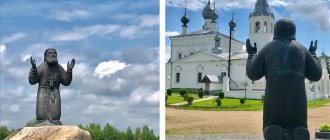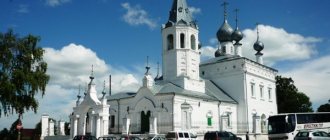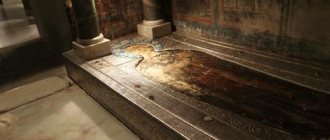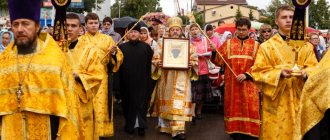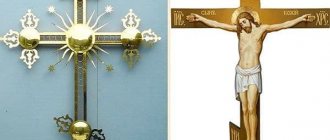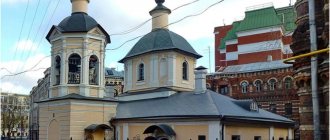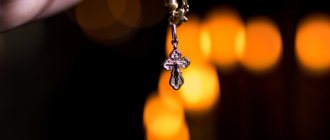The Holy Cross is a symbol of our Lord Jesus Christ. Every true believer, at the sight of him, is involuntarily filled with thoughts about the death throes of the Savior, which he accepted to deliver us from eternal death, which became the lot of people after the fall of Adam and Eve. The eight-pointed Orthodox cross carries a special spiritual and emotional load. Even if there is no image of the crucifixion on it, it always appears to our inner gaze.
An instrument of death that has become a symbol of life
The Christian cross is an image of the instrument of execution to which Jesus Christ was subjected to a forced sentence imposed by the procurator of Judea Pontius Pilate. For the first time, this type of killing of criminals appeared among the ancient Phoenicians and through their colonists, the Carthaginians, it came to the Roman Empire, where it became widespread.
In the pre-Christian period, it was mainly robbers who were sentenced to crucifixion, and then the followers of Jesus Christ accepted this martyrdom. This phenomenon was especially frequent during the reign of Emperor Nero. The very death of the Savior made this instrument of shame and suffering a symbol of the victory of good over evil and the light of eternal life over the darkness of hell.
What does it help with?
One of the four images of the Savior should be in the home of any believer, since daily prayers are performed in front of it and this is the visible presence of the Lord in our lives. But what they pray to the icon of the King of Glory in specific cases can be reduced to the following postulates:
- prayers to her help, first of all, those people who occupy positions of authority; this is natural, since the Lord appears in this form precisely as a King, a Master, which means He can help those who are responsible for others;
- Jesus Christ will certainly provide it to those bosses who turn to Him with all sincerity and hope for help, and if the boss is interested in this help, everything will work out in his life, and he will receive what he was counting on;
- But, first of all, an ordinary person must have such an icon in his home and turn to the Savior with any request in full confidence that he will receive help.
Important! These icons are always present in the home of any person who has even a little faith in Christ and his promise, and He always lives up to these expectations.
Prayer to Jesus Christ in front of the icon
The sacrament of prayer becomes special under the gaze of three saints. Their faces are open, their eyes are kind and soulful. There is no fear, I want to open up to the Lord, because in his features there is no menace or condemnation, but only blessing and light. And often they ask God not only for themselves, but they seek protection for loved ones and relatives, in order to save them and protect them.
“Oh, Great Savior! King of all who reign and rule! You are the Son of our Lord! Lord of Heaven! You are the judge of all living and dead souls on earth. You are our hope. You are our support. In You, Most Holy One, is our consolation and tranquility! Don't judge me by my deeds. Please forgive me all my sins, guide me on the righteous and true path. Do not leave me in moments of fear and despair. Only you can save me from despondency. You are my heart. You are my soul. My hope and faith are in You! Take my soul to Your Kingdom when judgment is completed! You are the only judge of all the worldly people. I ask, my Savior, grant me good health, strength of spirit, pure and bright kindness, and do not leave my family and friends. Forgive us for moments of doubt about Your power and might, O King of Heaven and Earth! Let Your will be done! From now on and forever and ever. Amen".
The image of Jesus Christ is a unique icon that conveys all the power and authority of the Son of God over sinful people. To achieve well-being, you need to read prayers daily, cleansing your soul of evil and negativity.
The eight-pointed cross is a symbol of Orthodoxy
The Christian tradition knows many different designs of the cross, from the most common crosshairs of straight lines to very complex geometric designs, complemented by a variety of symbolism. The religious meaning in them is the same, but the external differences are very significant.
In the countries of the eastern Mediterranean, Eastern Europe, as well as in Russia, since ancient times, the symbol of the church has been the eight-pointed, or, as they often say, the Orthodox cross. In addition, you can hear the expression “cross of St. Lazarus,” this is another name for the eight-pointed Orthodox cross, which will be discussed below. Sometimes an image of the crucified Savior is placed on it.
External features of the Orthodox cross
Its peculiarity lies in the fact that in addition to two horizontal crossbars, of which the lower one is large and the upper one is small, there is also an inclined one, called the foot. It is small in size and located at the bottom of the vertical segment, symbolizing the crossbar on which Christ’s feet rested.
The direction of its inclination is always the same: if you look from the side of the crucified Christ, then the right end will be higher than the left. There is a certain symbolism in this. According to the words of the Savior at the Last Judgment, the righteous will stand on his right hand, and sinners on his left. It is the path of the righteous to the Kingdom of Heaven that is indicated by the raised right end of the footstool, while the left one faces the depths of hell.
According to the Gospel, a board was nailed over the Savior’s head, on which was written by the hand of Pontius Pilate: “Jesus of Nazareth, King of the Jews.” This inscription was made in three languages - Aramaic, Latin and Greek. This is what the small upper crossbar symbolizes. It can be placed either in the interval between the large crossbar and the upper end of the cross, or at its very top. Such an outline makes it possible to reproduce with the greatest reliability the appearance of the instrument of Christ’s suffering. That is why the Orthodox cross has eight points.
Description and meaning of the icon “King of Kings”
Most of the “King of Kings” icons contain the image of three holy images: the Savior, the Mother of God and the prophet John. Traditionally, the icon also contains angels depicted below. They symbolize sacred benefits that they perform to please the Lord, protecting people and bringing faith and hope into their lives.
There are clear rules for all images of Christ:
- a cross with a letter designation within the Greek alphabet, which is translated as Jesus Christ, is always inscribed in the halo;
- the face itself is elongated, is always depicted facing the viewer and has subtle facial features;
- The Savior always wears simple clothes and his face is turned to the one who looks at him.
But in addition to these images of the incarnate Lord, there is also the icon of Jesus Christ the King of Glory, which is important among believers and especially those who occupy some kind of high leadership position.
There are also independent icons with this plot. At the shrine, Jesus sits proudly on a royal throne, dressed in the robes of rulers. His clothes contain red and gold colors.
The icon symbolizes the connection between the Old Testament and New Testament churches, which is carried out through the King of Glory, the Lord of Lords - Jesus Christ. The centuries-old history of the icon puts it on par with the most famous miraculous ones. For more than a thousand years, the concept of Jesus as the King of Kings and Lord of Lords has become the most revered.
Description of the Holy Face
The icon differs from all its previous images, first of all, in this:
- The Savior is shown in all his majesty, seated on a throne;
- he is dressed in royal clothes, which are called dalmatic, that is, a shirt with sleeves up to the wrist and lor, a long ribbon with which the clothes of kings and high dignitaries were tied.
Both the dalmatic and the long ribbon are all clothes of both commoners and nobles. It’s just that commoners didn’t tie up Dalmatics. In the icon of Jesus Christ the King of Glory, they are transformed in their appearance, united in their meaning and acquiring a special right, as the unifying affiliation of all people through Jesus Christ.
Important! In this case, the image of the King of Kings is interpreted both as a real ruler, a judge of the people and as a bishop who decides all the affairs of his people. Separates the righteous from the sinner and determines the fate of each of them.
In fact, this icon defines what Jesus Christ was formally executed for, what was depicted on the tablet nailed to the cross by order of Pontius Pilate. Namely, that he is the “King of the Jews.” This could be perceived as a political claim to dominance over a certain territory, but in fact it was the proclamation of the King of Kings in general over all the rulers of the world by right of his heavenly reign, determined by the Lord.
About the law of the golden ratio
The eight-pointed Orthodox cross in its classic form is built according to the law of the golden ratio. To make it clear what we are talking about, let us dwell on this concept in a little more detail. It is usually understood as a harmonic proportion, which in one way or another underlies everything that is created by the Creator.
One example of this is the human body. Through simple experiment, we can be convinced that if we divide the value of our height by the distance from the soles to the navel, and then divide the same value by the distance between the navel and the top of the head, the results will be the same and amount to 1.618. The same proportion lies in the size of the phalanges of our fingers. This ratio of quantities, called the golden ratio, can be found literally at every step: from the structure of a sea shell to the shape of an ordinary garden turnip.
The construction of proportions based on the law of the golden ratio is widely used in architecture, as well as other fields of art. Taking this into account, many artists manage to achieve maximum harmony in their works. The same pattern was observed by composers working in the genre of classical music. When writing compositions in the style of rock and jazz, it was abandoned.
The law of constructing an Orthodox cross
The eight-pointed Orthodox cross is also built on the basis of the golden ratio. The meaning of its ends has been explained above; now let us turn to the rules underlying the construction of this main Christian symbol. They were not established artificially, but resulted from the harmony of life itself and received their mathematical justification.
The eight-pointed Orthodox cross, drawn in full accordance with tradition, always fits into a rectangle, the aspect ratio of which corresponds to the golden ratio. Simply put, dividing its height by its width gives us 1.618.
The Cross of Saint Lazarus (as mentioned above, this is another name for the eight-pointed Orthodox cross) in its construction has another feature associated with the proportions of our body. It is well known that the width of a person’s arm span is equal to his height, and a figure with arms spread to the sides fits perfectly into a square. For this reason, the length of the middle crossbar, corresponding to the span of Christ’s arms, is equal to the distance from it to the inclined foot, that is, his height. These seemingly simple rules should be taken into account by every person who is faced with the question of how to draw an eight-pointed Orthodox cross.
The meaning of the icon of the Savior Not Made by Hands
This miraculous icon of the Savior includes a couple of special details: • The holy image is a mandatory subject in the training program for icon painters and is their final work; • This face of the Savior is considered a unique image of the Lord with a halo, a completed appearance. This means peace and completeness of the structure of the universe; • Proportionality of the image of Jesus' face. They only slightly squint their eyes to the side to betray more life. The proportionality of the image symbolizes the proportionality of all God's creatures; • The icon of the Savior does not show suffering or grief. She radiates peace, harmony and purity, as well as complete freedom from the manifestation of any feelings. The icon is most often cited as an illustration of the concept of “immaculate beauty”; • On the shrine there is a portrait of the Savior, only his face. This characteristic has different meanings. One of them says that the head emphasizes the supremacy of the soul over the body, and also symbolizes the fact that the leader in spiritual life is still Jesus Christ. The holy image is a unique and only image of the appearance of Jesus Christ. Other Images of the Savior depict him in full growth or in motion.
Calvary Cross
There is also a special, purely monastic eight-pointed Orthodox cross, a photo of which is presented in the article. It is called the “cross of Golgotha.” This is the outline of the usual Orthodox cross, which was described above, placed above the symbolic image of Mount Golgotha. It is usually presented in the form of steps, under which bones and a skull are placed. To the left and right of the cross a cane with a sponge and a spear can be depicted.
Each of these items has a deep religious meaning. For example, skull and bones. According to Sacred Tradition, the sacrificial blood of the Savior, shed by him on the cross, falling on the top of Golgotha, seeped into its depths, where the remains of our ancestor Adam rested, and washed away the curse of original sin from them. Thus, the image of the skull and bones emphasizes the connection of the sacrifice of Christ with the crime of Adam and Eve, as well as the New Testament with the Old.
Deisis King of Kings
The “Present Queen” icon, which we mentioned earlier, like the King of Kings, belongs to a type called “deisis,” which translates as “prayer” or “petition.” There is an erroneous pronunciation of “Deesis,” apparently due to its consonance with the name of the Savior. Such images are always placed in the center of the iconostasis, as the dominant ones.
The icon of the King of Kings (we offer a photo of it in the article) can be written on three separate boards, instead of one. Moreover, what is especially interesting is that one of the 15th-century variations is in the Tretyakov Gallery as an example of the art of icon painting.
The image symbolizes the connection between the New and Old Testaments through our Savior - Jesus Christ.
The meaning of the image of the spear on the cross of Golgotha
The eight-pointed Orthodox cross on monastic vestments is always accompanied by images of a cane with a sponge and a spear. Those familiar with the text of the Gospel of John well remember the dramatic moment when one of the Roman soldiers named Longinus pierced the Savior’s ribs with this weapon and blood and water flowed from the wound. This episode has various interpretations, but the most common of them is contained in the works of the 4th century Christian theologian and philosopher St. Augustine.
In them he writes that just as the Lord created his bride Eve from the rib of sleeping Adam, so from the wound in the side of Jesus Christ inflicted by the spear of a warrior, his bride the church was created. The blood and water spilled during this, according to St. Augustine, symbolize the holy sacraments - the Eucharist, where wine is transformed into the blood of the Lord, and Baptism, in which a person entering the bosom of the church is immersed in a font of water. The spear with which the wound was inflicted is one of the main relics of Christianity, and it is believed that it is currently kept in Vienna, in the Hofburg Castle.
The meaning of the image of a cane and a sponge
Equally important are the images of the cane and the sponge. From the accounts of the holy evangelists it is known that the crucified Christ was twice offered drink. In the first case, it was wine mixed with myrrh, that is, an intoxicating drink that dulls pain and thereby prolongs the execution.
The second time, having heard the cry “I thirst!” from the cross, they brought him a sponge filled with vinegar and bile. This was, of course, a mockery of the exhausted man and contributed to the approach of the end. In both cases, the executioners used a sponge mounted on a cane, since without its help they could not reach the mouth of the crucified Jesus. Despite such a gloomy role assigned to them, these objects, like the spear, were among the main Christian shrines, and their image can be seen next to the cross of Calvary.
Symbolic inscriptions on the monastic cross
Those who see the monastic eight-pointed Orthodox cross for the first time often have questions related to the inscriptions inscribed on it. Specifically, these are the IC and XC at the ends of the middle bar. These letters stand for nothing more than the abbreviated name – Jesus Christ. In addition, the image of the cross is accompanied by two inscriptions located under the middle crossbar - the Slavic inscription of the words “Son of God” and the Greek NIKA, which means “winner”.
On the small crossbar, symbolizing, as mentioned above, a tablet with an inscription made by Pontius Pilate, the Slavic abbreviation ІНЦІ is usually written, meaning the words “Jesus of Nazareth, King of the Jews,” and above it - “King of Glory.” It became a tradition to write the letter K near the image of a spear, and T near the cane. In addition, from about the 16th century, they began to write the letters ML on the left and RB on the right at the base of the cross. They are also an abbreviation and mean the words “The Place of the Execution is Crucified.”
In addition to the listed inscriptions, it is worth mentioning two letters G, standing to the left and right of the image of Golgotha, and being the initial ones in its name, as well as G and A - Head of Adam, written on the sides of the skull, and the phrase “King of Glory”, crowning the monastic eight-pointed Orthodox cross. The meaning contained in them fully corresponds to the Gospel texts, however, the inscriptions themselves can vary and be replaced by others.
King of Glory: Real name of Jesus Christ (9995 characters)
KING OF GLORY: REAL NAME OF JESUS CHRIST
According to legend, the first to attribute Jewish roots to Christ and his teaching were the Jews Ebion and Cerinthus (1st century AD). Jacob E. Conner, an American historian, linguist, economist, political scientist and diplomat, in his much-acclaimed book “Christ was not a Jew”, which was reprinted several times in the United States, calls the heresy of the Ebionites “the first of all heresies,” so how the apostles themselves anathematized her.
They were anathematized because they perfectly remembered the real Jesus. And they knew that his mother, who was from Scythia, remained a virgin, even being betrothed to the Jew Joseph! And she never shared a bed with him.
“The birth of Christ was like this: after the betrothal of His Mother Mary to Joseph, before they were united, it turned out that She was pregnant with the Holy Spirit” (Matthew 1:18).
'And Joseph took his wife, and did not know her, and behold, she gave birth to her firstborn son' (Matthew 1:24, 25).
Both the Roman Catholic and the Orthodox Autocephalous Church have always condemned this heresy. Arguments against the Ebionites contain the work of John Origen “On the Beginnings” (II century AD), the treatise of John Chrysostom “Against the Jews” (III century AD), the Word of Hilarion, Metropolitan of Kiev “On Law and Grace” (XI century from R.H.) and many others. The Local Council in Moscow (1504 AD), repeating the decision of the Apostolic Council in Jerusalem (49 AD), pronounced an anathema on the Ebionites.
The nationality of any person is determined by blood, language and the country where he was born. In the first centuries AD, Jesus was called 'Galilean' after the land where He came from and where His Mother, the Blessed Virgin, came from.
The prophet Isaiah also said: “Galilee is pagan” (Isaiah 9:1), that is, non-Jewish. In 721 BC. The Assyrian king Sargon crushed Israel and scattered its ten tribes. After which he populated it with the Galilean Scythians. Because “the Scythians struck terror into the hearts of the Jews,” as Conner writes, and “came from those regions of the North that are now known to mankind as Russia.” That is why the Jews of the first centuries were ordered by the rabbis to call Jesus from Nazarene (the country that was at the Dawn) nothing else , like Ben Pardus, that is, the Son of the Lynx.
And this is not surprising.
The face of Christ has been preserved to our times by the Savior Not Made by Hands. Or, as it is now called, the Shroud of Turin.
Scientists measured and studied the image saved by Spas. And they came to the conclusion that he was a tall, proportionally built, muscular man with regular facial features, long hair and a beard, completely unlike a Jew.
Academician of the Russian Academy of Sciences A.T. Fomenko in his work 'Tsar of the Slavs' gives his own dating of the birth of the Son of God and his death, based on astronomical research and mathematical calculations. He also cites numerous historical evidence, on the basis of which he draws a conclusion confirming the rightness of the apostles.
The Son of God was brought into the world by a Slavic woman!
Appeared in the year when the Supernova (the so-called 'Bethlehem') Star flashed in the sky, heralding with its light the incarnation of the Son of God. And she mourned his departure to the Other World in the year when the shadow of a total solar eclipse floated over the Earth and covered it with darkness.
The Byzantine emperor Andronikos I Komnenos (1182-1185 AD) repeated down to the smallest details the life (and cross) path of Jesus described in the Gospels. He endured persecution by Basileus Manuel Komnenos (New Testament King Herod), fled with his mother to her homeland - Rus' (New Testament Galilee), wandered around different cities and villages, and then returned in triumph to Tsar-Grad (New Testament Jerusalem) and ruled for three years (three years' public ministry of Christ). He ruled wisely and fairly, protecting the people and eradicating the abuses of the nobility. And then Isaac was betrayed by the Angel, whom he had previously exalted (New Testament Judas, Old Testament Satanail). Andronicus was beheaded, his eye was gouged out, his right hand was cut off (all these wounds were imprinted on the Shroud), and then he was crucified (the New Testament passion of Christ).
But if the tablet with the mocking inscription 'King of the Jews' somehow fits into the outline of the details of the villainous murder of the Son of God set out in the Gospels, then the reasons for the appearance of the inscription 'KING OF GLORY', as noted in his work 'King of the Slavs' by RAS academician A.T. Fomenko, we don’t understand.
“In numerous images of the crucifixion, Christ is called the ‘King of Glory,’” writes Fomenko, “The interpretation of this name of Christ is considered not entirely clear. Usually a very general and vague explanation is offered, something like 'Glorious King'. On the other hand, there is a problem - where did the name 'Slavs' come from?
Academician Fomenko was able to notice a serious inconsistency in the generally accepted version of the Gospel events. But, unfortunately, I could not interpret it correctly.
Referring to the fact that 'in the era of Andronikos I Komnenos, the title SEBAST or SEVASTOCRATOR existed. In Greek it means GLORY', Fomenko claims that 'the inscription 'King of Glory', placed on images of the crucifixion of Christ, indicates the title of Andronicus - GLORY, that is, the popular name of the Komnenos dynasty. But then Christians, that is, the followers of Andronicus-Christ, should have received the name Slavs, as followers of SLAVA, writes Fomenko. - We come to the conclusion that the very name SLAV is, simply, another name for Christians. It is not for nothing that the Slavs are still mostly Christians. And the Church Slavonic language is accepted precisely in Christian worship and only in it. Therefore, instead of TSAR OF GLORY, one could completely say TSAR OF THE SLAVS. The meaning is the same.'
Indeed the meaning is similar. And it would be possible to say that. However, exactly what was said was said. And what is written (including on images of the crucifixion) is exactly what is written. Therefore, it is advisable to interpret this precisely. And not what could have been, if. Piling one assumption on top of another only removes us from the solution.
Let us trace the chain of assumptions proposed by A.T. Fomenko in the opposite direction. Tsar of the Slavs - Tsar of Glory - Tsar Sevast - Basileus Sevast - Basileus Sevastokrator.
We've arrived. It's time to decide. So Basileus? Or is it Sevastokrator?
Can a Boyar be a Tsar, and a Vizier be a Sultan? Probably it can. First with this, and then with this. If he manages to seize power. But it’s unlikely to be both at the same time.
The author respects the work of academician A.T. Fomenko. However, he offers a different interpretation of the inscription 'KING OF GLORY' on images of the crucifixion.
The title 'King of Glory' (unlike the titles 'Basileus' and 'Sevastokrator') never existed in nature. One can agree with the assumption that SLAVA are Christians, followers of Christ, who inherited his 'family name'. But even the clergy, according to the same Fomenko, interpret this inscription not as “King of Christians,” but “very vaguely” - something like “Glorious King.” One way or another, no historical evidence of the existence of this title (much less its transmission by inheritance) has yet been discovered.
Yes, this is not required.
The appearance of this inscription is explained very simply. TSAR-SLAVI or TSRL-SLVI (as this word was written on old icons, without vowels) is not a title, but a name. Received at birth. Or sticking to a person later. In the form of a nickname.
However, at a time when the incorrect title of a sovereign sovereign was recognized as a crime against majesty and was punishable by death, an attempt to call someone the Tsar inevitably led to the rack. Or to the cross. This is exactly what happened to Jesus. Not to mention the fact that the sign with the inscription 'King of the Jews' (both the crime and the sentence) was already nailed to the cross. Consequently, 'Ts(a)Pb-SL(a)B' is not a nickname, but a name received at birth.
Now let's see if there is a name similar in sound to this phrase in the Slavic Name Book.
There are such names! Moreover, as many as two! ZARESLAV (glorifying the dawn) and ZORESLAV (illuminated with glory). If we abandon the modern spelling (that is, remove the vowels, take into account the softness of the sound 'Рь' and the hardness of the sound 'Въ', as well as the alternation of the sounds Z-S and Ts-S in the Russian language), in both cases we get TSRLSLV.
In ancient times, a Slav at birth received a name corresponding to the level of his spiritual development, of which there were four - vedun (spiritual teacher), knight (warrior), vesya (farmer, merchant, artisan) ismerd (servant). The presence of two roots in a name indicates that the person bearing it is born in both body and spirit. Such names were given to sorcerers (Zare-Slav) and knights (Zore-Slav), vesi had the same root name (Zoryan), and smerdas were content with nicknames (Zyryai).
The name of the knight consisted of words associated with virtue, courage in battle and nobility. The name ZORESLAV, meaning 'illuminated with glory', was given to those whose duty it was to fight for justice.
The name of the sorcerer consisted of words meaning goodness, glorification of the Almighty, joy, love, knowledge. This is exactly the name that could have been and, most likely, was given to the Son of God when he came into this World. The name ZARESLAV, meaning “glorifying the dawn,” was given to those who possessed wisdom, were able to control the mind and feelings, had tolerance and simplicity, purity, knowledge, truthfulness, faith and devotion to the Progenitor. The life goal of such a person is to live in spirituality and preach the doctrine.
Everything that we know about the life and deeds of the Son of God testifies to his wisdom, tolerance, simplicity, purity, knowledge, truthfulness and devotion to the Progenitor. In addition, ZARESLAV, which is written through the initial letter 'Az', in contrast to ZORESLAV, which is written through 'On', is closer in sound to the name 'KING OF GLORY', attributed to Jesus from Nazarene (the country that is at the Dawn) by a centuries-old tradition.
And one more note. The title “Caesar” or CAESAER, once so popular among the ruling sovereigns, is read as “Se-Dawn” (the Slavic initial letter C “word” is pronounced as “Съ”, and the initial letter S “zelo” as “Зъ”), i.e. 'Here is the Dawn.' Thus, the title “Tsar” that appeared out of nowhere finally receives a clear explanation. In the first centuries of Christianity, it meant hereditary membership in the family of the Son of God ZARESLAV and was pronounced like ZAR. And only later was it changed to the faceless and incomprehensible TSAR. In order to obscure the true origin of the KING OF GLORY.
Immortality granted by faith
It is also important to understand why the name of the eight-pointed Orthodox cross is associated with the name of St. Lazarus? The answer to this question can be found on the pages of the Gospel of John, which describes the miracle of his resurrection from the dead, performed by Jesus Christ, on the fourth day after death. The symbolism in this case is quite obvious: just as Lazarus was brought back to life by the faith of his sisters Martha and Mary in the omnipotence of Jesus, so everyone who trusts in the Savior will be delivered from the hands of eternal death.
In the vain earthly life, people are not given the opportunity to see the Son of God with their own eyes, but they are given his religious symbols. One of them is the eight-pointed Orthodox cross, the proportions, general appearance and semantic load of which became the topic of this article. It accompanies a believer throughout his life. From the holy font, where the sacrament of baptism opens the gates of the Church of Christ for him, right up to the gravestone, an eight-pointed Orthodox cross overshadows him.
History of the icon of Christ
The Image of the Lord “King of Glory,” presumably from the late 19th century, painted in the Byzantine style by the icon painter Theodore Nefedov, depicts Jesus Christ seated on a throne with an open Gospel and a scepter in his hand.
The Son of God in the “King of Glory” icon is dressed in royal robes, with a crown on his head and appears in the image of a Tsar. The icon is crowned with an image of God the Father and the Holy Spirit in the form of a dove (the Lord is represented in all three forms).
The painting of the image of the Lord “King of Glory” is associated with the plot of the holy book of the Apocalypse, and the present celebration in honor of him is attributed to the second coming of Christ in the Glory of the King-Judge.
According to the church traditions of our time, the celebration in honor of this image falls on the third preparatory Sunday before Great Lent on the Sunday of the Last Judgment.
The first image of Jesus Christ was given by himself. When a messenger from the king of Edessa, who was suffering from leprosy, sent an artist to paint the face of Christ, from which, as he sincerely believed, he could be healed.
But the artist could not approach Christ in any way to make an accurate portrait, and then Jesus Christ washed his face in water and, taking the cloth (obrus), wiped himself with it, and after that an image of the face of Christ appeared on the obrus.
This was the first image of the Savior in which only His face is visible; later, icons of this type received the name of the Savior Not Made by Hands. Based on this image, icon painters developed several more versions of the icon of the Savior.
- Emmanuel, when Jesus is depicted as a child of a youth, and the image is half-length, and a characteristic sign that it is the Savior is a halo with a cross, which belongs only to icons of Jesus Christ.
- Almighty. This is, as a rule, Christ in his half-length depiction of the Lord, seated on a throne and holding the Holy Scriptures in his right hand, and blessing people with his left hand
- Deesis, this word can be translated as prayer, here the King of Kings sits on a throne, and on both sides of him the Most Holy Theotokos and St. John the Baptist, who bowed before him in a prayer position. Sometimes the apostles and some saints are also depicted as those present.
On a note! There are several more images of Christ on icons such as “The Great Bishop of the Savior”, “Christ the Good Silence”, “The Good Shepherd” and “Christ in the Tomb”. These icons are always displayed in the form of the Shroud on Holy Saturday, when believers can venerate throughout the day, until the beginning of Easter Vespers.
The plot of this icon can be based on stories from the Holy Scriptures, which describe the birth of Jesus, who became the King of all Jews. But the earthly people denied the Son of God, who came to the human world preaching about the Lord, and executed Him.
Thus, we can conclude that the holy image of the “King of Kings” contains the idea of ruling over people. For His bright reign on earth, Jesus was ultimately crucified. Having risen again, the Savior gave the people a promise to return to the sinful earth in all His Power and Greatness in order to become a judge for all mankind and administer justice.
Pectoral symbol of the Christian faith
The custom of wearing small crosses made from a variety of materials on the chest appeared only at the beginning of the 4th century. Despite the fact that the main instrument of Christ’s passion was an object of veneration among all his followers literally from the first years of the establishment of the Christian Church on earth, at first it was customary to wear medallions with the image of the Savior on the neck rather than crosses.
There is also evidence that during the period of persecution that took place from the middle of the 1st to the beginning of the 4th century, there were voluntary martyrs who wanted to suffer for Christ and painted the image of the cross on their foreheads. They were recognized by this sign and then given over to torture and death. After the establishment of Christianity as the state religion, wearing crosses became a custom, and during the same period they began to be installed on the roofs of churches.
How to Pray to Jesus Christ
If you don’t know how and what to ask God for, say briefly: “Lord, grant me and my family everything that is useful to us, bless our life.”
You can also read “Our Father,” the words of which were known to all our ancestors (there was even an expression “to know like the Lord’s Prayer”) and which every believer should teach his children. If you don’t know its words, learn them by heart; you can read the “Our Father” prayer in Russian:
“Our Father who is in Heaven! May your name be holy and glorified, may your kingdom come, may your will be done, both in heaven and on earth. Give us the bread we need today; and forgive us our debts, which we forgive our debtors; and may we not have the temptations of the devil, but deliver us from the influences of the evil one. For Yours is in heaven and earth the Kingdom and the power and the glory of the Father, and the Son, and the Holy Spirit forever. Amen".
Or read a prayer to the Lord, glorifying His Resurrection and omnipotence, in Russian:
“Seeing the Resurrection of Christ, let us worship the Holy Lord Jesus, the only Sinless One! We worship Your Cross, O Lord Christ, and we sing and glorify Your Holy Resurrection! You are our God, we have no other gods besides You, we magnify Your Name! Come, all believers, let us worship the Holy Resurrection of Christ - after all, joy came to the whole world through the Cross of Christ! Always blessing the Lord, we glorify His Resurrection because He Himself endured crucifixion and conquered death by death!”
Turning to God Himself is the most important prayer. Pray to the Lord Almighty at any moment in life:
- Ask the Lord for help in any matter, everyday difficulties and troubles,
- Pray in danger
- Ask for help with the needs of your loved ones and friends,
- Repent before God of your sins, asking to forgive them, to let you see your mistakes and vices and correct yourself,
- Praying for healing in illness,
- Turning to Him in sudden danger,
- When you have anxiety, despondency, sadness in your soul,
- Thank Him for your joys, successes, happiness and health.
We advise you to study How Orthodox Christians greet each other?
"Holy Supper of the Lord"
Another icon depicting Jesus Christ is “The Holy Supper of the Lord.” It personifies the event that happened on Maundy Thursday - the penultimate day of the Savior’s presence among people. Jesus gathered the 12 apostles at one table.
Jesus blessed the bread and gave it to one of the disciples, saying: “Eat, for this is My body.” Then he blessed the cup of wine, saying the following words: “Drink, it’s all from her.”
"The Last Judgment"
The Last Judgment icon symbolizes the end of the world, which will occur after the Second Coming of Jesus Christ. At this time, the Last Judgment will take place on sinful and righteous people. After this, man will unite with God forever, and the world will be renewed.
The icon also depicts hell, the underworld, where all sinners will go (bottom left) and heaven, in which righteous people will live forever (top right).
Two types of body crosses in Ancient Rus'
In Rus', symbols of the Christian faith appeared in 988, simultaneously with its baptism. It is interesting to note that our ancestors inherited two types of pectoral crosses from the Byzantines. It was customary to wear one of them on the chest, under clothes. Such crosses were called vests.
Along with them, the so-called encolpions appeared - also crosses, but somewhat larger in size and worn over clothing. They originate from the tradition of carrying reliquaries with relics, which were decorated with the image of a cross. Over time, encolpions were transformed into the pectoral crosses of priests and metropolitans.
Where to hang an icon in the house
Rice.
6. It is necessary to find a special place for the icon in the house so that nothing distracts the person praying from prayer. Since ancient times, a pious tradition has been established in Rus' of placing icons in the “Red Corner”, that is, in a special prayer place where, according to the spiritual hierarchy, all household shrines are collected.
Nowadays you can still see such “red corners” in many houses of pious Orthodox families. But nevertheless, this tradition has changed somewhat: more and more often, icons began to be hung not only in the “red corner”, but also on walls (more often facing the East). Now every Orthodox believer strives to consecrate every room in his home with icons and therefore arranges such a small “prayer corner” in almost every room.
This icon is a type of iconographic image of the Savior, and therefore usually occupies a central place in the home iconostasis. More often this icon is placed either in the living room or in the bedroom.
Tip #1 Placing icons is allowed in any room, with the exception of the bathroom and toilet. The main thing is that there are no foreign objects, paintings, photographs, posters, etc. in this place that distract and scatter the attention of the worshiper.
You can simply hang icons on a nail, or you can make or buy a special shelf for icons, which will help you conveniently and beautifully place all the images.
The main symbol of humanism and philanthropy
Over the millennium that has passed since the time when the Dnieper banks were illuminated by the light of Christ's faith, the Orthodox tradition has undergone many changes. Only its religious dogmas and basic elements of symbolism remained unshakable, the main one of which is the eight-pointed Orthodox cross.
Gold and silver, copper or made of any other material, it protects a believer, protecting him from the forces of evil - visible and invisible. As a reminder of the sacrifice made by Christ to save people, the cross has become a symbol of the highest humanism and love for one's neighbor.

